Is Imodium Safe for Dogs in 2025? Vet Reviewed Guide to Loperamide Use 🐶💊

In this article
Is Imodium Safe for Dogs in 2025? Vet Reviewed Guide to Loperamide Use 🐶💊
By Dr. Duncan Houston BVSc
When your dog gets diarrhea, your medicine cabinet might seem like a quick fix—but over-the-counter Imodium (loperamide) requires caution. As a veterinarian, I’ll guide you through when Imodium is appropriate (non-infectious diarrhea, chemotherapy side effects), precise dosing, genetic risks, signs of complications, drug interactions, and safe alternatives. Let’s break down what you need to know to keep your pup safe and comfortable. 💡
1. 🧩 What Is Imodium & How It Works
Imodium is the brand name for loperamide, an FDA-approved human anti-diarrheal. Though not approved for dogs, vets can prescribe it off-label to treat:
- Non-infectious diarrhea (food intolerance, stress, chemo side effects)
- Increased intestinal absorption of fluids and nutrients by slowing gut motility
Loperamide works within 1–2 hours and is cleared within about 24 hours.
2. ✅ When Might Imodium Be a Good Idea
Imodium can help in specific scenarios, such as:
- Chemo or radiation therapy causing diarrhea
- Stress-related or mild dietary intolerance diarrhea
- Short-term, non-infectious colitis where no infection is present
Important: If diarrhea lasts more than 48 hours, is bloody, involves fever, vomiting, or lethargy—or infection is suspected—see your vet immediately.
3. 🧮 Safe Dosing by Weight
Vets calculate loperamide at roughly 0.08 mg/kg orally every 6–8 hours. Common capsule sizes and approximations:
- 10–25 lb (4.5–11 kg): 1 mg
- 26–40 lb (12–18 kg): 2 mg
- 41–60 lb (19–27 kg): 4 mg
Human labels aren’t reliable for dogs—consult your vet for accurate dosage guidance.
4. ⚠️ Genetic Risk: MDR1 Breeds
Certain breeds carry the MDR1 gene mutation, which disables P-glycoprotein—crucial for keeping loperamide out of the brain. Affected breeds include:
- Collies (~70% affected)
- Australian Shepherds (~50%)
- Shetland Sheepdogs, German Shepherds, Longhaired Whippets, Old English Sheepdogs
If a dog has the MDR1 mutation, even low doses of Imodium can cause neurological toxicity—tremors, seizures, coma. NEVER give Imodium without confirming MDR1 status.
5. 🧪 Side Effects to Watch For
Loperamide can cause:
- Constipation, bloat
- Sedation or lethargy (especially in MDR1 breeds)
- Lethargy, drooling, abdominal discomfort
- Rare: toxic megacolon, angioedema, anaphylaxis—mainly in humans but precautionary in dogs
If symptoms appear, stop Imodium and call your vet.
6. 💊 Drug Interactions & Contraindications
Interference occurs with drugs affecting P-glycoprotein or causing CNS effects:
- CNS depressants—diazepam, acepromazine, trazodone
- Antifungals like ketoconazole, antibiotics like erythromycin
- P-glycoprotein inhibitors like quinidine
- Not for bacterial/toxin-induced diarrhea or with bowel-blocking anticholinergics
Always inform your vet about all medications being taken.
7. 🏥 When Imodium Is Contraindicated
Never use Imodium if:
- Diarrhea is caused by infection, toxin, parasite, or fever
- Puppy is under 12 weeks old or pregnant/nursing
- MDR1-positive breed or no prior genetic testing
In these cases, supportive care, hydration, diagnostic tests, or vet-approved alternatives are safer.
8. 📋 Veterinarian Monitoring Protocol
When prescribed, vets will recommend:
- Short 1–2 day use with dosage guidance based on weight
- Frequent hydration—wet food and extra water
- Monitoring stool, appetite, energy, and bowel routines
- Follow up if no improvement or symptoms worsen
9. 🏡 Supportive Care at Home
Whether or not your dog gets Imodium, try:
- ➡️ Bland diet (boiled chicken & rice) for 24–48 hours
- ➡️ Probiotics & prebiotic supplements to restore balance
- ➡️ Small, frequent meals to ease digestion
- ➡️ Clean water available at all times
- ➡️ Track bowel movements and behavior
10. ⚡ When to Call the Vet
Immediate vet attention is needed if your dog shows:
- Diarrhea lasting >48 hours or bloody stools
- Lethargy, vomiting, fever, or signs (sunken eyes, dry gums)
- Neurological signs—tremors, staggering, seizures after dosing
11. 🌿 Alternatives to Imodium
When Imodium isn’t right, consider:
- Probiotics & prebiotics (e.g. from Woopf) to rebalance gut flora
- Fiber supplements like canned pumpkin
- Bismuth subsalicylate (Pepto-Bismol) under vet supervision
- Prescription diets formulated for GI health
12. 🛠️ Tools & Products for Digestive Support
- Ask A Vet App: 24/7 vet chats for immediate GI concerns
- PetMD Calming Chews: melatonin/chamomile to ease stress-related upset
13. 🐕 Breed-Specific Guidance
Some scenarios:
- MDR1 breeds: never give Imodium unless tested negative; instead use fiber, probiotics
- Small/Toy breeds: low weight means a small misdose → high risk. Only under vet care.
- Seniors: weakened liver/kidney function → use low doses and frequent monitoring.
14. ✅ Final Checklist Before Giving Imodium
- Fresh diarrhea, but no infection signs
- Dog >12 weeks old, not pregnant/nursing
- Genetic testing confirmed MDR1-negative
- No interacting medications
- Clear dosing plan based on weight
- Support plan: hydration, diet, monitoring
- Follow‑up care scheduled
📌 Key Takeaways
- Imodium can help certain cases of non-infectious diarrhea in dogs
- Genetic risks—especially in MDR1 breeds—require testing
- Strict weight-based dosing and vet supervision are essential
- If symptoms persist or worsen, stop dosing and seek vet care
- Alternatives—probiotics, bland diet, vet-approved meds—are often safer






